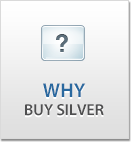If you’re interested in an investment in silver, but don’t want to carry physical bullion or are unwilling to make a longer term investment, a good option for you might be silver exchange traded products, or ETFs.
Exchange traded funds are specific to a certain product-silver in this case- which are traded based on major stock exchanges. The London Bullion Market Association, New York Mercantile Exchange, Tokyo Commodity Exchange, and Australian Securities Exchange are commonly followed. Silver exchange traded funds are useful in trading, rather than as an avenue for a long term investment.
The ETF Market
The value of your stake of silver in an exchange traded fund is based on the current spot price of silver. The spot price indicates the value of one troy ounce of 99.9% pure silver at a given point or place. Again, because these are traded using stock exchanges for reference, the spot price of silver is prone to fluctuation and can rise and fall multiple times a day. Spot prices do not include additional fees, such as broker fees and storage fees. Trading of shares of silver is done in a way similar to equities.
To claim shares of silver in an exchange traded fund, you can either make a call to a broker or go online and use an online stock brokerage. Online trading is not any riskier than traditional trading, and may be a good option for you as there are less associated costs. One good firm for first time traders to begin on is TD Ameritrade, who offers a virtual trading tool for you to learn the ins and outs of trading and gain practice with virtual money. Even if you don’t quite understand it at first, you’ll gain knowledge and know-how without even spending a penny.
Pros and Cons
The advantages of investing silver with exchange traded funds are numerous. For one, the additional associated costs with precious metal investment are not as high, as you do not have to pay shipping and handling fees, applicable sales taxes or VAT.
There is a lower premium on your investment. You also don’t need to worry about the security of your investment. The fund you select will safely store it for you, and you don’t need to worry about your share being stolen as you would physical silver. Trading shares of silver on an exchange is much easier and the market liquidity is high.
However, the drawback is that you own merely a share of a trust in the fund and will never actually own any physical silver from this investment. Unlike certificates, shares in an ETF are irredeemable for physical silver. You can only get cash in return. As it does reflect the current and constantly changing market price of silver, it is relatively volatile, and the spot price is subject to rise and fall on any given trading day.
Different popular exchange traded funds to follow include iShares Silver Trust, also called SLV, is the largest silver exchange traded fund today and is one of the most popular to invest in. iShares physically stores over 335 million troy ounces, or 10,000 tons, of silver in its reserves. iShares Silver trust offers a cost-effective solution to trading and its security is top notch.
ETFS Physical Silver is provided by ETF Securities and is backed by physical allocated silver bullion. Large Canadian-based funds Silver Bullion Trust and Central Fund of Canada are closed-end funds, both offering silver and are physically backed. While not the most popular option, it offers a much lower capital gains tax rate and is definitely worth looking into.





